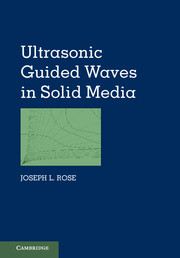Book contents
- Frontmatter
- Contents
- Nomenclature
- Preface
- Acknowledgments
- 1 Introduction
- 2 Dispersion Principles
- 3 Unbounded Isotropic and Anisotropic Media
- 4 Reflection and Refraction
- 5 Oblique Incidence
- 6 Waves in Plates
- 7 Surface and Subsurface Waves
- 8 Finite Element Method for Guided Wave Mechanics
- 9 The Semi-Analytical Finite Element Method
- 10 Guided Waves in Hollow Cylinders
- 11 Circumferential Guided Waves
- 12 Guided Waves in Layered Structures
- 13 Source Influence on Guided Wave Excitation
- 14 Horizontal Shear
- 15 Guided Waves in Anisotropic Media
- 16 Guided Wave Phased Arrays in Piping
- 17 Guided Waves in Viscoelastic Media
- 18 Ultrasonic Vibrations
- 19 Guided Wave Array Transducers
- 20 Introduction to Guided Wave Nonlinear Methods
- 21 Guided Wave Imaging Methods
- Appendix A Ultrasonic Nondestructive Testing Principles, Analysis, and Display Technology
- Appendix B Basic Formulas and Concepts in the Theory of Elasticity
- Appendix C Physically Based Signal Processing Concepts for Guided Waves
- Appendix D Guided Wave Mode and Frequency Selection Tips
- Index
- Plates
- References
17 - Guided Waves in Viscoelastic Media
Published online by Cambridge University Press: 05 July 2014
- Frontmatter
- Contents
- Nomenclature
- Preface
- Acknowledgments
- 1 Introduction
- 2 Dispersion Principles
- 3 Unbounded Isotropic and Anisotropic Media
- 4 Reflection and Refraction
- 5 Oblique Incidence
- 6 Waves in Plates
- 7 Surface and Subsurface Waves
- 8 Finite Element Method for Guided Wave Mechanics
- 9 The Semi-Analytical Finite Element Method
- 10 Guided Waves in Hollow Cylinders
- 11 Circumferential Guided Waves
- 12 Guided Waves in Layered Structures
- 13 Source Influence on Guided Wave Excitation
- 14 Horizontal Shear
- 15 Guided Waves in Anisotropic Media
- 16 Guided Wave Phased Arrays in Piping
- 17 Guided Waves in Viscoelastic Media
- 18 Ultrasonic Vibrations
- 19 Guided Wave Array Transducers
- 20 Introduction to Guided Wave Nonlinear Methods
- 21 Guided Wave Imaging Methods
- Appendix A Ultrasonic Nondestructive Testing Principles, Analysis, and Display Technology
- Appendix B Basic Formulas and Concepts in the Theory of Elasticity
- Appendix C Physically Based Signal Processing Concepts for Guided Waves
- Appendix D Guided Wave Mode and Frequency Selection Tips
- Index
- Plates
- References
Summary
Introduction
This chapter outlines basic concepts and analysis of viscoelasticity and its impact on wave propagation. Even though the attenuation due to viscoelastic effects has plagued investigation in ultrasonic NDE for years, limited progress has been made in the study of viscoelasticity, especially in guided wave analysis. However, the reality calls for an understanding of attenuation principles as a function of material properties, wave modes, and frequency. In this chapter, we present possible approaches and discuss a few sample problems.
In many guided wave problems, material viscoelasticity may be ignored in the calculations and analysis of mode selection and wave propagation. However, in this chapter, we examine situations where a consideration of viscoelasticity is important. Significant advances have been made recently in the ability to efficiently model and solve for guided wave modes in viscoelastic waveguides that has aided our understanding of wave propagation.
General elastic theory assumes that, during deformation, a material stores energy with no dissipation. This is accurate for most metals, ceramics, and some other materials. However, many modern artificial materials, including polymers and composites, dissipate a great deal of energy during deformation. The behavior of these materials combines the energy-storing features of elastic media and the dissipating features of viscous liquids; such materials are called viscoelastic. Stresses for viscoelastic materials are functions of strains and derivatives of strains over time. If the stresses and strains and their derivation over time are related linearly, then the material has properties of linear viscoelasticity. It is important to note that viscoelastic material properties are typically very sensitive to temperature changes.
Information
- Type
- Chapter
- Information
- Ultrasonic Guided Waves in Solid Media , pp. 323 - 344Publisher: Cambridge University PressPrint publication year: 2014
References
Accessibility standard: Unknown
Why this information is here
This section outlines the accessibility features of this content - including support for screen readers, full keyboard navigation and high-contrast display options. This may not be relevant for you.Accessibility Information
- 2
- Cited by
